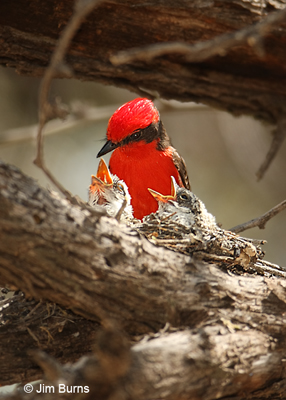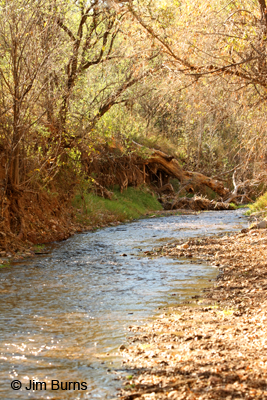
(PSCP) is just south of the town of Patagonia, a tiny ranching community on Highway 82 southeast of Tucson. It lies in a lovely valley, cool in summer, cold in winter, between the Canelo Hills and the Santa Rita Mountains and was TNC's first project in Arizona. It encompasses the first two miles of Sonoita Creek's permanent waterflow, and was purchased to preserve one of the last remaining stands of cottonwood/willow riparian forest in the state.
Over the years the magnificent diversity of habitat along the creek's floodplain has attracted several bird species whose normal breeding range lies south of our border with Mexico. This visitation of rarities, typically in winter, has lured birders from all over the country and has included Blue Mockingbird and Crescent-chested Warbler, the former the first of its species ever recorded in North America.
Late last summer another first North American record bird, a Sinaloa Wren, was discovered on the PSCP and happily overwintered there. Or unhappily. This wren is well known as both a melodic songster and a secretive recluse, difficult to find and see well even in its preferred habitat in Mexico. With the onset of cooler fall temperatures, its singing ceased and vigilant birders were rewarded only with snatches of its ratcheting call only every few days. Actual sightings of this skulker in the thick tangles of underbrush near a creek cutbank on Blue Heaven Road along the preserve's western boundary came several days apart.
Now spring has come to southern Arizona, warming up the wren's song though the bird is still difficult to spot. The listening and looking (one lister friend from Iowa used up 16 vacation days before finally getting a glimpse) however, have reintroduced many birders to the more routine and expected avian wonders of PSCP--the confiding ravens with their vast repertoire of sound, the mixed flocks of wintering sparrows, the raptors patrolling the grassy fields and, coincidental with spring's arrival, the return of much sought breeding species such as Gray Hawk, Violet-crowned Hummingbird, and Vermilion Flycatcher.
As the migrants return, wildflowers are blooming, trees are budding, and Sonoita Creek purls with runoff from higher elevations. Even the listers who came specifically for the Sinaloa Wren are shortening their vigil at the cutbank to rediscover the preserve's inner trails. Bewick's Wrens and Lucy's Warblers are busy with nest building, deer and javelina are sometimes seen by quiet hikers, and there was a recent mountain lion sighting. This is southeastern Arizona at its best during its best time of year. Patagonia-Sonoita Creek is one of Arizona's oldest and longest preserved birding treasures. Go now. The Sinaloa Wren is just a nice gratuity for the listers.